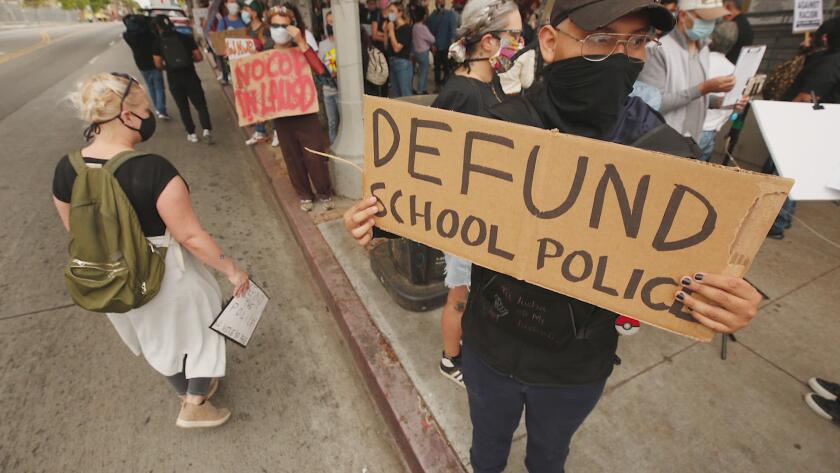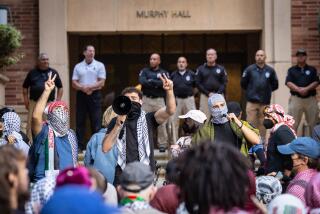LAUSD board to decide whether to defund school police

Nationwide, protesters and activists have been calling to “defund the police.” But what does it actually mean? And why are so many people calling for it to happen?
A uniformed and armed school police officer pepper-sprays students at a campus in Los Angeles. Is that excessive force, even police brutality, or a rare but justifiable de-escalation of an incident that otherwise could have become more dangerous?
As the Los Angeles Unified School District’s Board of Education debates the future of its 471-member police department Tuesday, two distinct interpretations are emerging from similar data on police involvement at schools: one points toward eliminating officers on campus; the other toward keeping them in place.
The seven-member L.A. Board of Education on Tuesday will consider three competing resolutions. Board member Monica Garcia has proposed essentially eliminating the department in a phased approach beginning July 1, 2021. Her plan has backing from activist groups, students and community members who’ve called for defunding the school police.
Their longtime campaign gained traction amid nationwide protests over police brutality under the banner of Black Lives Matter, spurred by the May 25 death of George Floyd in Minneapolis police custody. Two weeks ago, the leadership of the Los Angeles teachers union voted to do away with the $70-million school police department and use the funds for such needs as counselors and nurses.
The school board also will consider two other proposals. Each calls for a panel to study policing; one includes additional changes, such as a hiring freeze and a ban on the use of pepper spray.
L.A. schools Supt. Austin Beutner has supported a ban on pepper spray. But he cautioned Monday against moving immediately to terminate the school police department.
“No person should feel the presence of a safety officer on a campus as an indictment of them or their character,” Beutner said. “Students deserve to be heard on this topic and their views taken into account.”
All the same, he said, “those who want to abolish school police must provide a reasoned answer how the threats of mass violence and incidences of serious crime will be handled at schools. And they need to explain to those who are in favor of school police why campuses will be safer in their absence.”
Watch LA Times Today at 7 PM/10PM on channel 1 on Spectrum News 1, and on Cox systems in Palos Verdes and Orange County on channel 99.
Also Monday, those opposing school police made their case at an online news conference, with both personal narratives and a new policy brief from UCLA researchers and advocates.
The policy brief, from the Black Male Institute at UCLA, noted that reports to a district incident tracking system — which records anything that affects school functions — are on the rise.
While these incidents can include mundane matters such as lost keys, those that appeared to fall under the purview of police rose 76% over the eight school years ending in 2018-19. Meanwhile, calls for students who are exposed to trauma and violence or who are displaying suicidal behavior rose 906% over that same period, in what researcher Elianny Edwards said shows “an increasing need for mental health providers.”
Reports of suicidal behavior — which include ideation, self-harm and hospitalization — accounted for 24% of all incidents.
The brief also noted that since the 2005-06 school year, L.A. Unified has experienced an 18% decrease in enrollment, even as the school police budget has increased by 48%. Meanwhile, the ratio of counselors to students, as specified in the teachers union contract, is 500 to 1 for secondary schools.
The brief calls for doubling the number of counselors, in addition to increasing the ranks of social workers and other staff devoted to mental health. A logical source of funding would be the school police budget, the researchers wrote.
Beutner on Monday suggested that about 10% of the current police budget could be quickly redirected to counseling without impairing security.
At the same time, the school system put forward a different but overlapping data set, suggesting that school police take on important work, without which schools would be less safe.
In 2018-19, the last full school year during which campuses were open, police investigated 131 mass shooting threats, four bomb threats and 77 assaults with a deadly weapon. There were 294 campus lockdowns, more than half from an off-campus threat. There also were 321 calls for burglaries, five reported rapes and four guns recovered on campuses. And over the last 11 months, the district has recorded 913 “crimes against persons.”
The district reported that its officers used pepper spray in 11 incidents during the 2018-19 school year, seven of which involved students.
The statistics released Monday differ from those the district provided to The Times last week, when the data were organized by calendar year and did not specify how many incidents involved students.
To the activists, the only correct number for pepper-spray incidents is zero.
But L.A. school police Deputy Chief Leslie Ramirez said that in some situations, the use of pepper spray is safer for students and officers than physically wading into an altercation, for example.
“We are looking at every single situation that involves pepper spray and other uses of force to make sure that if there is any issue that we’re seeing with improper deployment or use, that we immediately address that and provide the necessary training,” she said.
The district has declined to release incident reports and internal reviews of officers’ use of pepper spray.
District officials have repeatedly characterized the school police department as a national leader in adopting policing reforms. In particular, they emphasize efforts by officers and other school staff to divert students into counseling for problems that previously would have resulted in suspensions, arrests and expulsions.
Some of these changes cited by police and district officials followed pressure by activists.
While some of the threat felt by students may be unintended, it’s still detrimental, said Jan Williams, an L.A. Unified bus driver and parent. She said that several years ago, when her son was 12, he was terrified to see police on a city bus, after a Cleveland police officer fatally shot Tamir Rice, a Black boy his own age.
Seeing armed, uniformed police on campus reinforces that trauma and fear, said Williams. She also noted the disproportionate number of Black students arrested on campus, a finding documented in earlier research.
“Enough is enough,” said 16-year-old Emmanuel Karunwi, an 11th-grader at University Pathways Medical Magnet Academy. “Some of the people who are least impacted by police have had the most say about how policing should happen in our community.
“What you have been seeing these past few weeks is a movement led by Black folks [and] allies demanding we move from a society dependent on cops to a society rooted in care,” he said.
In its data, the district noted that one armed officer is assigned to each high school, while middle schools have an unarmed security aide. Elementary schools are monitored by roving patrols. But groups of officers can converge quickly on a campus in response to a call. The department includes 344 armed officers, as well as detectives, civilian support staff and dispatchers.
Beutner acknowledged that Black students have talked of feeling targeted by police, but he noted that Black students also are disproportionately the victims of incidents to which police are responding to provide assistance.
“Those looking for a simple answer will be disappointed, because it does not exist,” Beutner said.
If you or someone you know is exhibiting warning signs of suicide, seek help from a professional and call or text the National Suicide Prevention Lifeline at 1-800-273-TALK (8255).
More to Read
Sign up for Essential California
The most important California stories and recommendations in your inbox every morning.
You may occasionally receive promotional content from the Los Angeles Times.













